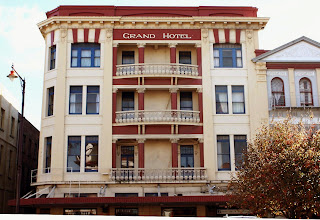Invercargill is the southernmost city in New Zealand, and in the whole Asia-Pacific region, around the same latitude of the Kerguelen Islands.
It lies in the heart of the wide expanse of the Southland Plains on the Oreti river's estuary, amid rich farmland, and is the commercial center of New Zealand's Southland region.
The Oreti flows southwards to the Pacific, through fertile flat lands.
The town center, the large Dee and Tay avenues, the Water Tower at left: built on flat land, it strangely reminds of arctic canadian and alaskan towns - most buldings are just two or three-storey high.
Coordinates: 46° 24′S, 168° 20′ E
Population: ~53 000
Bank Corner, the traditional town center
The Bank of New South Wales
Bank Corner is the intersection of Tay and Dee streets. In the middle of the roundabout is the Trooper's Memorial which honours those who died during the Boer War in South Africa.
When the commercial area moved some blocks away, the banks closed. They remain as remarkable architectural works and testimonies of an era of economic boom.
Built in 1878, the Bank of New Zealand is now the Bethel Centre, a Lutheran social organization.
The National Bank of New Zealand, on the Crescent, is now an Art gallery.
Many streets in the city, especially in the centre and main shopping district, are named after rivers in Great Britain, mainly Scotland: Dee and Tay, Tyne, Esk, Don, Thames, Mersey, Ness, Yarrow, Spey, and Eye rivers.
The corner of Dee and Tay.
The Alexander Building, on Dee street: late victorian style from 1901
The Grand Hotel, from 1913, with cast iron balustrade balconies.
Tay stret
The Town Hall and Theater, from 1906, where the town's cultural life takes place.
The theater auditorium can accomodate over 1000 spectators.
The Crescent
In this short curving street by the Bank corner is located the glorious Victoria Railway Hotel, from 1896 , with an octogonal turret and ornate balustrades:
Also in this building is the exclusive Gerrard's Restaurant
http://www.hotelinvercargill.com/
Esk Street
The home of the Southland Times newspaper, from 1908
Esk Street is the main shopping street of Invercargill. The west end of Esk Street is anchored by the new Wachner Place.
Wachner Place is the new comercial and civic open area, with pedestrian streets; it has become a place to sit and people watch.
Invercargill umbrella, a modern town's landmark on Don street.
Modern architecture, cafés and leisure facilities in Wachner Place.
The Water Tower:
Completed in 1889, it is 42.5 m high.
The Southlands boys high school:
St. Mary's basilica:
A catholic church on Tyne street, the basilica was completed in 1905 in the late Victorian style.
St Mary's Basilica is another one of the more notable landmarks of the city.
First Presbyterian church:
In polychrome brick, from 1915, after italian romanesque style.
Invercargill Civic Theater at night:
http://www.icc.govt.nz/ServicesA-Z/CivicTheatre/Theatreinformation.aspx
Aurora Australis (Southern Lights) are frequent over Invercargill, mainly around the equinoxes:































